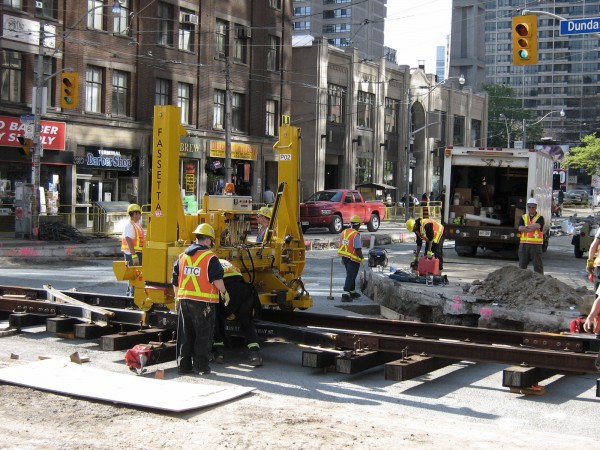When Metrolinx released its Investment Strategy on May 27, many urbanists rushed to endorse it, arguing that any plan to fund more transit was a good plan. Just as many critics rushed to denounce the strategy because it was financed by broad-based tax increases. In truth, so many observers prejudged the document that its details have escaped serious scrutiny. And that’s a problem, since those details include billions in uncounted, unallocated revenues.
Metrolinx’s strategy document is meant to backstop months of debate, and sell us on decades worth of new transit spending and dedicated revenue. The report and its appendices are hundreds of pages long, with countless anecdotes, quotes and photos.
Yet the report contains no clear breakdown of exactly how new tax revenues would flow in and out of Metrolinx coffers, when, or why. It’s true that the strategy does include a cash flow graph on P. 39 — but it’s abstract art, like a fiscal Rorschach test. No dates, dollar figures or numbers appear on the graph, only colorful lines. Metrolinx’s $2 billion revenue target appears as a straight black line, as if tax revenues never rise nor fall.
The conceit that the tax package will always raise “$2 billion per year” hides the potential impact of growth revenues. For example, Metrolinx repeatedly argues that a 1% HST hike raises $1.3 billion per year from the Greater Toronto Area in constant dollars. That’s not a plausible outcome.
As Metrolinx itself notes, sales tax revenues grow with the economy. Sometimes, they grow even faster. In the first full year of the HST regime (2011-12), Ontario sales tax revenues grew by 7%. Even if HST income grows at a modest 1.5% annually beyond inflation over the next two decades, this raises an additional $4 billion (in constant dollars) from the GTA alone.
Then there’s the parking tax. As proposed, it’s really a business property surtax, charged on the assessed land value of parking, rather than on the parking area as is done in other cities. Metrolinx recommends this untested, complicated alternative because it claims it will make the tax more equitable. Again, no data is included to support this, nor are there any examples to explain how the tax could impact different business sectors over time.
Time matters. Property values tend to rise over the long term. Cities usually gear-shift tax rates down to adjust accordingly. That’s why Toronto’s commercial and residential tax rates are almost a third smaller than they were in 2001, even though total revenues are much higher. A property that grows 10% in value doesn’t necessarily pay 10% more in property tax in a typical tax year.
However, as outlined in Metrolinx’s vague recommendations, the parking tax wouldn’t adjust for rising assessments — so revenues could easily soar like a property tax powered by rocket fuel. The document books $350m from parking in 2014. Suppose parkade assessments rise in the GTA by 3% annually — from higher valuations, new parking construction, or both. That raises another $2.4 billion over the following twenty years.
The headline dollar figures are lowballed, too. Metrolinx plans to spend $34 billion on new projects. The agency defines this figure as an “all-in” estimate, including financing, maintenance and contingency for cost overruns. So the strategy recommends tax tools sufficient to raise “$2 billion per year” over twenty years to fund this.
There’s one small problem: if you need $34 billion all-in, you need $34 billion. But $2 billion per year over twenty years raises $40 billion, not $34 billion.
The explanation for this $6 billion bonus seems to be carelessness; Metrolinx recommends 20 years of taxation, but it only benchmarks for 17 years of new spending. But if this distinction sounds innocuous, remember that projects will likely include some debt and P3 financing. Every additional year of incoming revenue can have a significant impact on debt-financed spending capacity.
Given the time taken, the money spent and the issues at stake, Metrolinx’s document should have transparently matched the flow of any revenue growth to a clear spending timetable. However, the failure to do could offer political benefits for several sides in the transit debate. Hardcore transit advocates now have more reason to defend the plan, since it is more generous than it looks. Premier Wynne’s government could also use growth revenue projections to buy some maneuvering room and table a smaller tax package.
That said, critics on the left and right have more ammunition, too. If you already thought Metrolinx’s tax plans were too rich for Ontario’s blood at $34 billion, a plan that’s billions richer will only reinforce that view. Seen in that light, the Investment Strategy reads a lot more like a sales pitch for new taxes with some transit projects attached, and a lot less like the carefully-staged financial plan that all sides deserved to see.
photo by OCAD123
![]()
Brian Kelcey is a public policy consultant and self-described “conservative urbanist.” His experience in urban policy includes work as a senior political advisor on transit policy at Queen’s Park in 2003, and as a budget advisor in Winnipeg’s Mayor’s Office from 2005-2008. Brian will occasionally contribute to Spacing’s urban blog network.






7 comments
There are many problems with Metrolinx’s report as I commented on the Torontoist website, but the lack of a detailed financial and construction staging plan are, as you point out, a major problem.
In the short term, presuming the taxes started in 2014, there is very little spending because none of the “Next Wave” projects is anywhere near “shovel ready”. Fine, that can build up a reserve to jump start work and allow pay-as-you-play for a period rather than having to finance heavy spending in early years of construction. But we have no idea of when that construction will occur as Metrolinx seems unwilling to put delivery dates in print for fear of them becoming “commitments”. They don’t even have alternative scenarios for how the projects might be staged and financed.
The issue of revenue growth has a counterpart in inflation. All of the Next Wave projects are priced in 2014$ and given the lead time to finish some of them, inflation will play a significant role. Some of the future revenue increases will have to offset inflation, but more importantly, as a matter of accountability, it may prove tricky untangling cost increases due to inflation and those due to scope creep or other politically induced design mods. (Unexpected construction conditions should already be covered in the project contingency allowance.)
That $2b/year, by the way, is only $1.5b for Metrolinx because the rest is earmarked for municipal projects. The total price of all Next Wave projects is about 15 years’ worth of revenue at $1.5b.
As a transit advocate (and fiscally conservative lefty who worries that poor financial planning can prevent us from building what we really need and damage the credibility of anything we propose), I find that Metrolinx’s approach of withholding info is very frustrating even though it might suit the government’s agenda. In many ways, I think they are still operating in “McGuinty” mode where lack of commitment, delay, and secrecy were routine.
Governments and the public cannot get behind a program if it is poorly presented and gives the sense of collecting money just for the sake of it without more specifics about when it will be spent and when people paying the taxes will see the benefits.
Thanks for scrutanizing a document that definitely needs more scrutiny. Is there any provincial precedent for annually readjusting a tax rate to the rate to try and collect a specific amount? Or do you think the Metrolinx report is just overestimating the amount needed so that the government can sell a (more politically digestible) reduced rate plan to the public?
Is it really surprising that this Liberal Government could resist the opportunity to generate extra tax revenue? Over and above what is needed for the “Big Move”. This is entirely Machiavellian. Better to make one large hit than many small ones.
There’s a lot of guess work in the governments and your estimations. The reality is construction projects tend to become more and more expensive over time, mostly because of unforeseen and unpredictable roadblocks during construction. The government is making a smart move by over-estimating the amount it will need for these projects, as opposed to having to come back and ask for additional funds every time a problem arises. When the government runs out of money – you end up with projects like the Sheppard Subway, half-finished and operating at a loss. If the government does end up with left-over money at the end of the process – tax refunds can be issued.
Also – I think someone should point out what this amount of taxation actually works out to for the average individual. 40 billion sounds huge – though it works out to be about 150 bucks per person per year, or 12 dollars a month. Assuming we’re all taxed at an equal rate. Is this number unreasonable? I don’t think so – most people are willing to fork out 128 dollars for a metropass each month, if you told them raising the price to 140 dollars would allow the system to expand and become more reliable, I think people would bite.
If we’re looking to the future on the whole package of proposed revenue tools, it’s worth noting that it’s possible the gas tax revenues will actually fall over time with improved emissions standards and increasing use of hybrid/electric vehicles (plus they won’t rise with inflation). So some of the increases in other parts may simply compensate for the lack of increase in the gas tax portion.
Right, but Oh so Wrong – “J”. 1) people are no longer fooled by this..’only cost you 4 dollars a day’, or whatever scheme…. it’s been done to us so many times and we only have one pocket! Toronto Water, “we didn’t fix it in your daddy’s time, so you will all pay 50 a month more”, McGuinty Gas, “we will all pay 40 a month more to pay off his cancellations” etc etc etc etc and 2) I don’t think anybody believes that this particular government, with it’s track record (and no, nothing has changed except the leader now wears skirts-and it un-elected) will dedicate this tax to transit. Forget the dollar amount, how exactly would you sell us all that this guv means what is says this time. Forget the past eHEatlth, Ornge, OHIP Health tax grab, NOW, the Libs are serious that this will be a dedicated tax for transit only! (Then you of course have the problem that outside of the GTA, nobody cares about transit, they have bridge issues, roads and so on. An then don’t forget that was transit-happy Wynne’s Libs that CANCELLED the Northerner Railway Train serving the folks up north…this is a tough sell!!!!!!!!!